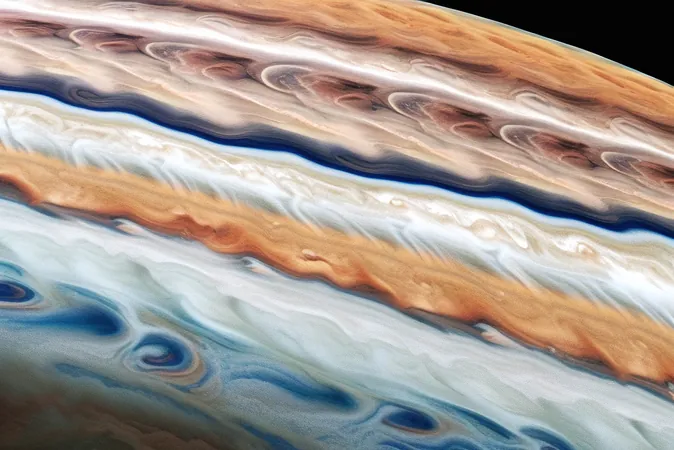
Breakthrough Discovery Unveils Secrets Behind Jupiter's Mysterious Clouds—Astronomers Left in Awe!
2025-01-06
Author: Nur
Breakthrough Discovery Unveils Secrets Behind Jupiter's Mysterious Clouds—Astronomers Left in Awe!
Jupiter, the gas giant renowned for its vibrant bands of clouds and iconic weather phenomena like the Great Red Spot, has captured the imagination of astronomers and enthusiasts alike for centuries. However, recent groundbreaking research led by a group of citizen scientists has upended long-standing beliefs about the planet's cloud composition, leaving experts astonished.
Traditionally, it was thought that Jupiter's visible clouds were primarily composed of ammonia ice. New insights, as detailed in the Journal of Geophysical Research – Planets, challenge this assumption and shed light on the complex dynamics of Jupiter's atmosphere.
Fresh Insights from Citizen Astronomers
The revolution in understanding Jupiter's clouds began with amateur astronomer Dr. Steven Hill from Colorado. Using commercially available telescopes and specialized color filters, Dr. Hill meticulously captured photos of Jupiter at various wavelengths, allowing him to assess ammonia levels and the altitude of cloud tops. His findings revealed that the clouds exist at temperatures too warm for ammonia ice to form, suggesting a far more intricate atmospheric system at play.
Following Dr. Hill's initial results, Professor Patrick Irwin from the University of Oxford utilized the same analytical techniques on data from the European Southern Observatory's Very Large Telescope in Chile. His team's sophisticated computer simulations confirmed that Jupiter’s primary cloud layers are situated deeper than expected, rendering the notion of pure ammonia ice clouds highly unlikely.
The Surprising Simplicity of Discovery
Professor Irwin expressed genuine astonishment at the effectiveness of Dr. Hill's straightforward methods. He stated, “I am amazed that such a simple technique can probe so deeply into the atmosphere and clearly demonstrate that the main clouds cannot be pure ammonia ice!” This research exemplifies how amateur astronomers can contribute valuable insights to scientific studies, potentially transforming our understanding of Jupiter’s atmospheric behaviors.
By analyzing subtle differences in brightness through specific color filters, Dr. Hill developed ammonia maps that provide an affordable alternative to complex computer modeling. He conveyed his enthusiasm for utilizing simple tools to uncover groundbreaking findings, stating, “The hope is that I can find new ways for amateurs to make significant contributions to professional research.”
Connecting Weather Changes to Ammonia Variations
The ammonia maps generated from these innovative methods allow citizen scientists and hobbyists to monitor Jupiter’s atmospheric changes easily. Researchers can correlate visible phenomena, such as the emergence of small storms and shifts in Jupiter’s famed bands, with measurements of ammonia, enhancing our understanding of the gas giant's meteorological patterns.
John Rogers from the British Astronomical Association highlighted the advantages of this technique, noting, “Amateurs can frequently use this method to link visible weather changes on Jupiter to ammonia fluctuations, providing critical insights into the planet’s weather system.”
Occasional Ammonia Ice Clouds and Chemical Dynamics
While the primary cloud composition has been redefined, some regions on Jupiter can still produce puffy ammonia ice clouds due to strong updrafts. Space missions, including NASA's Galileo and Juno, have documented these transient white clouds casting shadows onto darker layers below. Researchers suggest that in these instances, rapid uplift allows ammonia to condense before being broken apart or mixed with photochemical haze.
This phenomenon is crucial as it explains the intermittent bright patches of ammonia ice that punctuate Jupiter's otherwise darker cloud layers. The role of photochemistry is also significant, where sunlit ammonia-rich air undergoes reactions that either decompose ammonia or integrate it with other compounds, resulting in a cloud composition that is rich in ammonium hydrosulfide and other materials that give Jupiter its distinctive reddish-brown hues.
Extending Discoveries to Saturn
Inspired by the techniques applied to Jupiter, Professor Irwin's team directed their focus toward Saturn. Their analysis yielded similar results to those collected by the James Webb Space Telescope, revealing that Saturn's cloud layers also lie deeper than the ammonia condensation level. This suggests that analogous chemical processes and atmospheric dynamics may be at work on both gas giants, sparking further discussion surrounding their atmospheric connections.
The Implications of Understanding Jupiter's Clouds
These groundbreaking findings pave the way for more frequent and precise measurements of Jupiter's atmosphere. The simplicity of the new technique provides both amateur and professional astronomers with crucial tools for examining weather changes and gas distributions promptly. This can bolster ongoing research to uncover the evolution of storms, jet streams, and other atmospheric phenomena over time.
As researchers continue to explore both Jupiter and Saturn, they aim to map cloud levels and chemical compositions while correlating these discoveries with data collected by spacecraft. The combination of Earth-based telescopes, cutting-edge space instruments, and grassroots citizen science could unlock profound insights into the mesmerizing atmospheres of these enigmatic gas giants.
Stay tuned for more exciting developments in planetary science as astronomers unravel the mysteries of our solar system!


 Brasil (PT)
Brasil (PT)
 Canada (EN)
Canada (EN)
 Chile (ES)
Chile (ES)
 Česko (CS)
Česko (CS)
 대한민국 (KO)
대한민국 (KO)
 España (ES)
España (ES)
 France (FR)
France (FR)
 Hong Kong (EN)
Hong Kong (EN)
 Italia (IT)
Italia (IT)
 日本 (JA)
日本 (JA)
 Magyarország (HU)
Magyarország (HU)
 Norge (NO)
Norge (NO)
 Polska (PL)
Polska (PL)
 Schweiz (DE)
Schweiz (DE)
 Singapore (EN)
Singapore (EN)
 Sverige (SV)
Sverige (SV)
 Suomi (FI)
Suomi (FI)
 Türkiye (TR)
Türkiye (TR)
 الإمارات العربية المتحدة (AR)
الإمارات العربية المتحدة (AR)